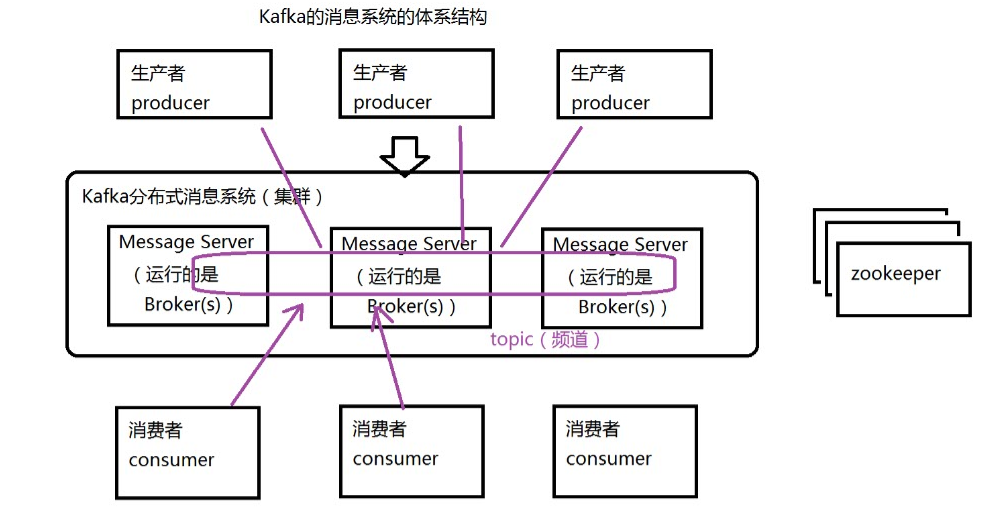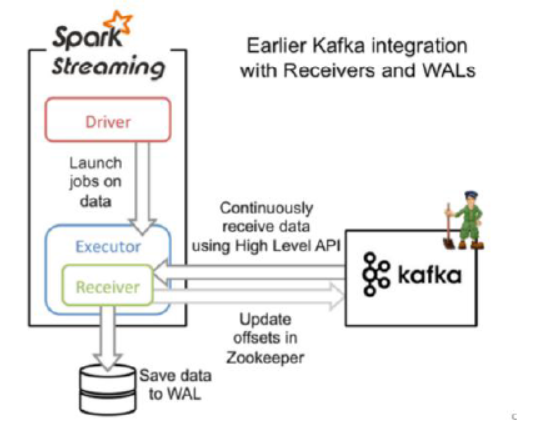三、集成:数据源
1、Apache Kafka:一种高吞吐量的分布式发布订阅消息系统
(1)
(*)消息的类型
Topic:主题(相当于:广播)
Queue:队列(相当于:点对点)
(*)常见的消息系统
Kafka、Redis -----> 只支持Topic
JMS(Java Messaging Service标准):Topic、Queue -----> Weblogic
(*)角色:生产者:产生消息
消费者:接收消息(处理消息)
(2)Kafka的消息系统的体系结构

(3)搭建Kafka的环境:单机单Broker的模式
//启动kafka
bin/kafka-server-start.sh config/server.properties &
测试Kafka
创建Topic
bin/kafka-topics.sh --create --zookeeper bigdata11:2181 -replication-factor 1 --partitions 3 --topic mydemo1
发送消息
bin/kafka-console-producer.sh --broker-list bigdata11:9092 --topic mydemo1
接收消息: 从zookeeper中获取topic的信息
bin/kafka-console-consumer.sh --zookeeper bigdata11:2181 --topic mydemo1
(4)集成Spark Streaming:两种方式
注意:依赖的jar包很多(还有冲突),强烈建议使用Maven方式
读到数据:都是key value
(*)基于接收器方式(receiver)
Receiver的实现使用到Kafka高层次的API.对于所有的Receivers,接收到的数据将会保存在Spark executors中,然后由Spark Streaming 启动Job来处理这些数据

1 package main.scala.demo 2 3 import org.apache.spark.SparkConf 4 import org.apache.spark.streaming.kafka.KafkaUtils 5 import org.apache.spark.streaming.{Seconds, StreamingContext} 6 7 object KafkaReceiverDemo { 8 9 def main(args: Array[String]): Unit = { 10 val conf = new SparkConf().setAppName("KafkaReceiverDemo").setMaster("local[2]") 11 val ssc = new StreamingContext(conf,Seconds(10)) 12 13 //指定Topic信息:从mydemo1的topic中,每次接受一条消息 14 val topic = Map("mydemo1" -> 1) 15 16 //创建Kafka输入流(DStream),基于Receiver方式,链接到ZK 17 //参数:SparkStream,ZK地址,groupId,topic 18 val kafkaStream = KafkaUtils.createStream(ssc,"192.168.153.11:2181","mygroup",topic) 19 20 //接受数据,并处理 21 val lines = kafkaStream.map(e=>{ 22 //e代表是每次接受到的数据 23 new String(e.toString()) 24 } 25 ) 26 27 //输出 28 lines.print() 29 30 ssc.start() 31 ssc.awaitTermination() 32 } 33 }
启动Kafka,在上面发送一条消息,结果

(*)直接读取方式:推荐(效率更高)
这种方式定期的从Kafka的topic+partition中查询最新的偏移量,再根据定义的偏移量在每个batch里面处理数据。当需要处理的数据来临时,spark通过调用kafka简单的消费者API读取一定范围内的数据。

package main.scala.demo import kafka.serializer.StringDecoder import org.apache.spark.SparkConf import org.apache.spark.streaming.kafka.KafkaUtils import org.apache.spark.streaming.{Seconds, StreamingContext} object KafkaDirectDemo { def main(args: Array[String]): Unit = { val conf = new SparkConf().setAppName("KafkaReceiverDemo").setMaster("local[2]") val ssc = new StreamingContext(conf,Seconds(10)) //指定Topic信息 val topic = Set("mydemo1") //直接读取Broker,指定就是Broker的地址 val brokerList = Map[String,String]("metadata.broker.list"->"192.168.153.11:9092") //创建一个DStream key value key的解码器 value的解码器 val lines = KafkaUtils.createDirectStream[String,String,StringDecoder,StringDecoder](ssc,brokerList,topic) //读取消息 val message = lines.map(e=>{ new String(e.toString()) } ) message.print() ssc.start() ssc.awaitTermination() } }
2、集成Apache Flume:两种方式
注意:依赖jar包Flume lib下面的Jar包,以及
(1)基于Flume Push模式: 推模式。Flume被用于在Flume agents 之间推送数据。在这种方式下,Spark Streaming可以建立一个receiver,起到一个avro receiver的作用。Flume可以直接将数据推送到该receiver。
a4.conf配置。
#bin/flume-ng agent -n a4 -f myagent/a4.conf -c conf -Dflume.root.logger=INFO,console
#定义agent名, source、channel、sink的名称
a4.sources = r1
a4.channels = c1
a4.sinks = k1
#具体定义source
a4.sources.r1.type = spooldir
a4.sources.r1.spoolDir = /root/training/logs
#具体定义channel
a4.channels.c1.type = memory
a4.channels.c1.capacity = 10000
a4.channels.c1.transactionCapacity = 100
#具体定义sink
a4.sinks = k1
a4.sinks.k1.type = avro
a4.sinks.k1.channel = c1
a4.sinks.k1.hostname = 192.168.153.1
a4.sinks.k1.port = 1234
#组装source、channel、sink
a4.sources.r1.channels = c1
a4.sinks.k1.channel = c1
package flume import org.apache.spark.SparkConf import org.apache.spark.streaming.flume.FlumeUtils import org.apache.spark.streaming.{Seconds, StreamingContext} object MyFlumeStream { def main(args: Array[String]): Unit = { val conf = new SparkConf().setAppName("SparkFlumeNGWordCount").setMaster("local[2]") val ssc = new StreamingContext(conf, Seconds(5)) //创建FlumeEvent的DStream val flumeEvent = FlumeUtils.createStream(ssc,"192.168.153.1",1234) //将FlumeEvent中的事件转成字符串 val lineDStream = flumeEvent.map( e => { new String(e.event.getBody.array) }) //输出结果 lineDStream.print() ssc.start() ssc.awaitTermination(); } }
测试:
1.启动Spark streaming程序MyFlumeStream
2.启动Flume:bin/flume-ng agent -n a4 -f myagent/a4.conf -c conf -Dflume.root.logger=INFO,console
3.拷贝日志文件到/root/training/logs目录
4.观察输出,采集到数据:

(2)自定义sink方式(Pull模式): 拉模式。Flume将数据推送到sink中,并且保持数据buffered状态。Spark Streaming使用一个可靠的Flume接收器从sink拉取数据。这种模式更加健壮和可靠,需要为Flume配置一个正常的sink
(*)将Spark的jar包拷贝到Flume的lib目录下
(*)下面的这个jar包也需要拷贝到Flume的lib目录下

(*)同时加入IDEA工程的classpath
#bin/flume-ng agent -n a1 -f myagent/a1.conf -c conf -Dflume.root.logger=INFO,console a1.channels = c1 a1.sinks = k1 a1.sources = r1 a1.sources.r1.type = spooldir a1.sources.r1.spoolDir = /root/training/logs a1.channels.c1.type = memory a1.channels.c1.capacity = 100000 a1.channels.c1.transactionCapacity = 100000 a1.sinks.k1.type = org.apache.spark.streaming.flume.sink.SparkSink a1.sinks.k1.channel = c1 a1.sinks.k1.hostname = 192.168.153.11 a1.sinks.k1.port = 1234 #组装source、channel、sink a1.sources.r1.channels = c1 a1.sinks.k1.channel = c1
package flume import org.apache.spark.SparkConf import org.apache.spark.storage.StorageLevel import org.apache.spark.streaming.flume.FlumeUtils import org.apache.spark.streaming.{Seconds, StreamingContext} object FlumeLogPull { def main(args: Array[String]) { val conf = new SparkConf().setAppName("SparkFlumeNGWordCount").setMaster("local[2]") val ssc = new StreamingContext(conf, Seconds(10)) //创建FlumeEvent的DStream val flumeEvent = FlumeUtils.createPollingStream(ssc,"192.168.153.11",1234,StorageLevel.MEMORY_ONLY_SER_2) //将FlumeEvent中的事件转成字符串 val lineDStream = flumeEvent.map( e => { new String(e.event.getBody.array) }) //输出结果 lineDStream.print() ssc.start() ssc.awaitTermination(); } }
开启flume:
bin/flume-ng agent -n a1 -f myagent/a1.conf -c conf -Dflume.root.logger=INFO,console
测试步骤和推模式类似。